Accounting Integrated Reporting: Financial Statement Analysis Report
VerifiedAdded on 2021/12/23
|14
|2476
|22
Report
AI Summary
This report provides a comprehensive analysis of accounting integrated reporting, encompassing financial statement analysis, ratio calculations, and corporate governance principles. Part A presents a detailed ratio table, calculating key financial ratios such as current ratio, quick ratio, cash ratio, inventory turnover, receivables turnover, debt-to-asset ratio, debt-to-equity ratio, interest coverage, ROE, and ROA. Part B focuses on the common-size balance sheet and consolidated statement of cash flows, identifying potential financial red flags and warning signs. Part C delves into the application of corporate governance principles, specifically examining the structure of the board for adding value (Principle 2), safeguarding integrity in corporate reporting (Principle 4), recognizing and managing risk (Principle 7), and acting ethically and responsibly (Principle 3). The analysis utilizes the 2015 annual report of Dick Smith as a case study, evaluating the company's compliance with ASX guidelines and identifying areas for improvement. The report incorporates a skeptical view, highlighting potential shortcomings in the company's disclosures and practices. References are included to support the analysis.
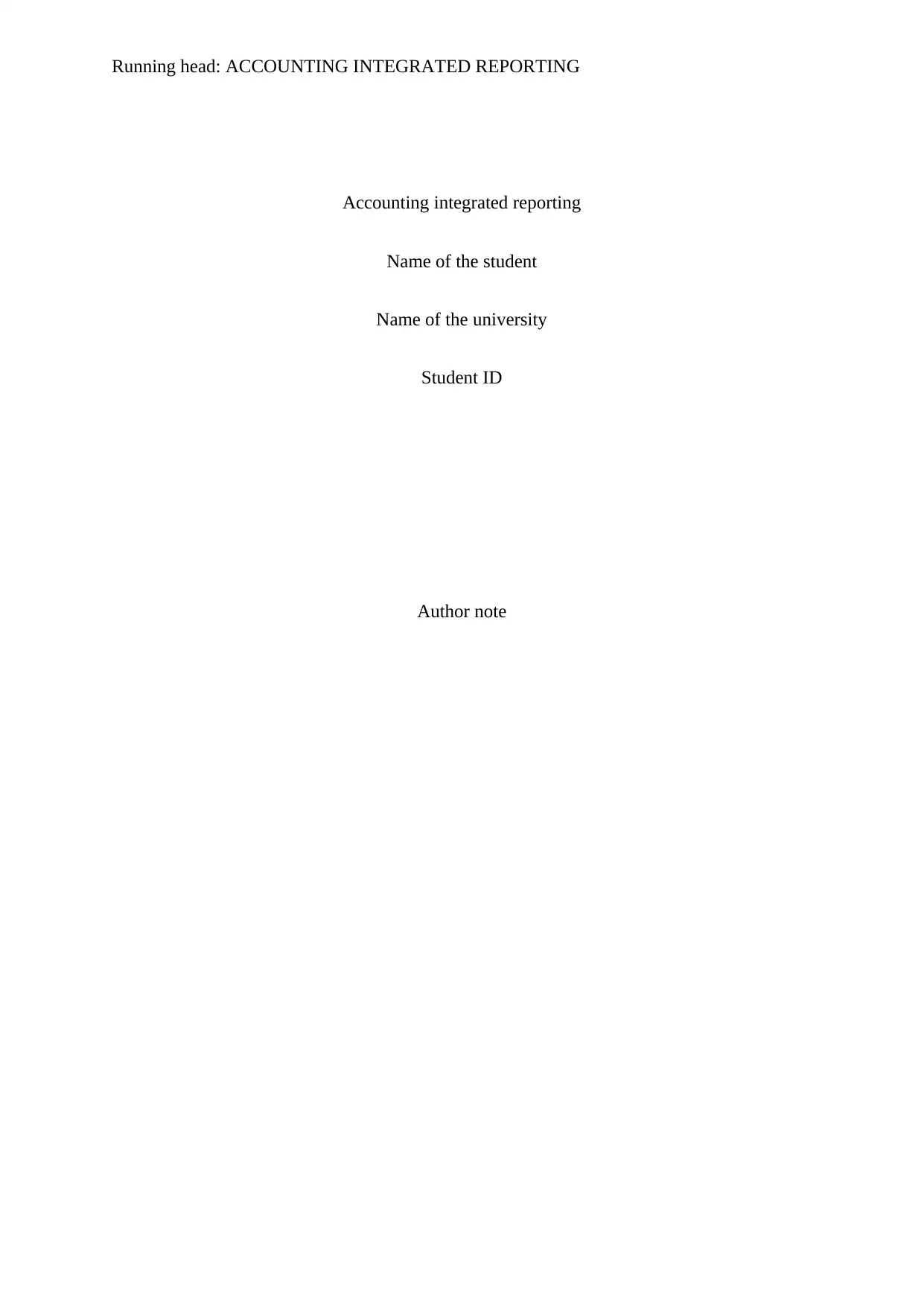
Running head: ACCOUNTING INTEGRATED REPORTING
Accounting integrated reporting
Name of the student
Name of the university
Student ID
Author note
Accounting integrated reporting
Name of the student
Name of the university
Student ID
Author note
Paraphrase This Document
Need a fresh take? Get an instant paraphrase of this document with our AI Paraphraser
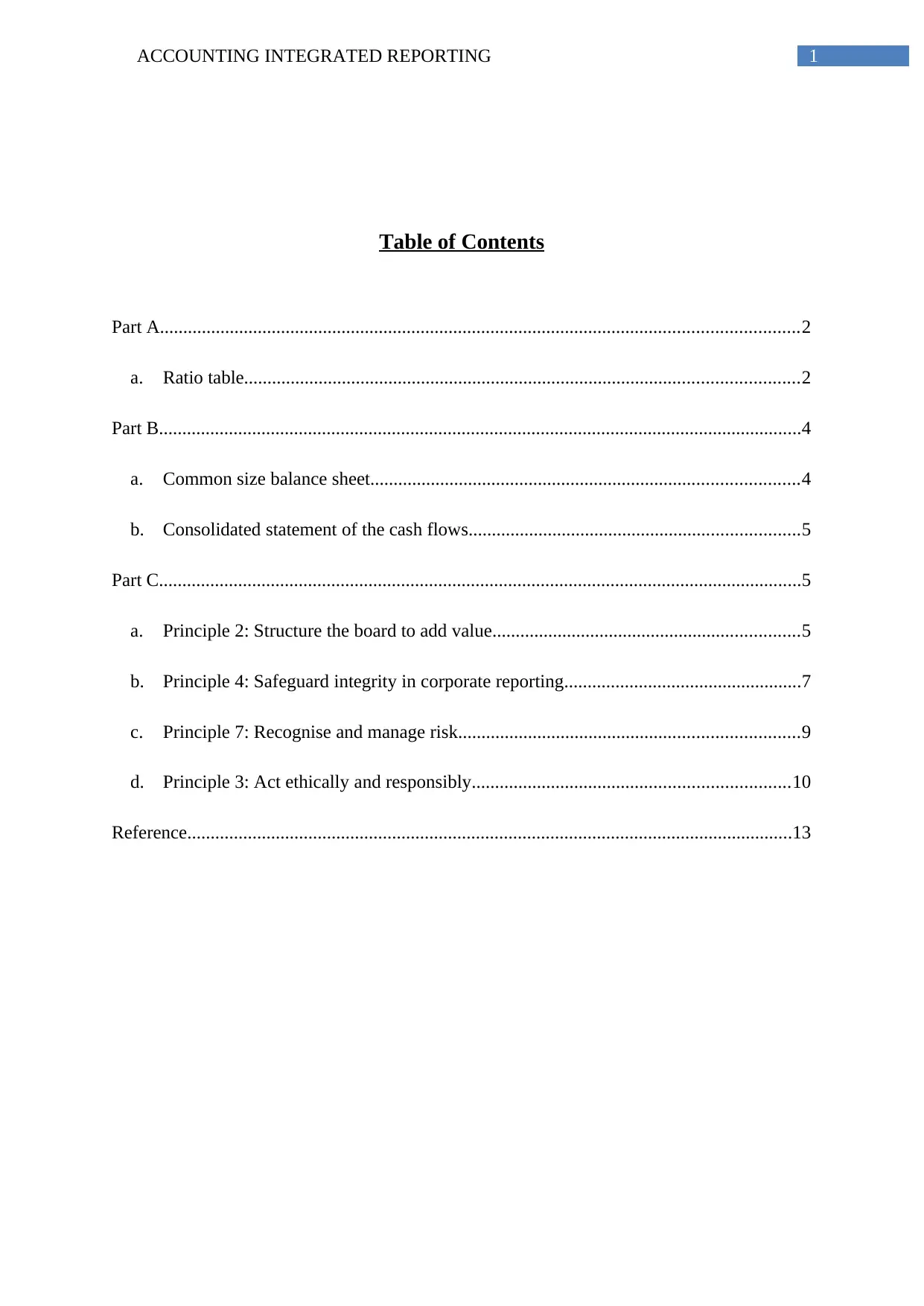
1ACCOUNTING INTEGRATED REPORTING
Table of Contents
Part A.........................................................................................................................................2
a. Ratio table.......................................................................................................................2
Part B..........................................................................................................................................4
a. Common size balance sheet............................................................................................4
b. Consolidated statement of the cash flows.......................................................................5
Part C..........................................................................................................................................5
a. Principle 2: Structure the board to add value..................................................................5
b. Principle 4: Safeguard integrity in corporate reporting...................................................7
c. Principle 7: Recognise and manage risk.........................................................................9
d. Principle 3: Act ethically and responsibly....................................................................10
Reference..................................................................................................................................13
Table of Contents
Part A.........................................................................................................................................2
a. Ratio table.......................................................................................................................2
Part B..........................................................................................................................................4
a. Common size balance sheet............................................................................................4
b. Consolidated statement of the cash flows.......................................................................5
Part C..........................................................................................................................................5
a. Principle 2: Structure the board to add value..................................................................5
b. Principle 4: Safeguard integrity in corporate reporting...................................................7
c. Principle 7: Recognise and manage risk.........................................................................9
d. Principle 3: Act ethically and responsibly....................................................................10
Reference..................................................................................................................................13
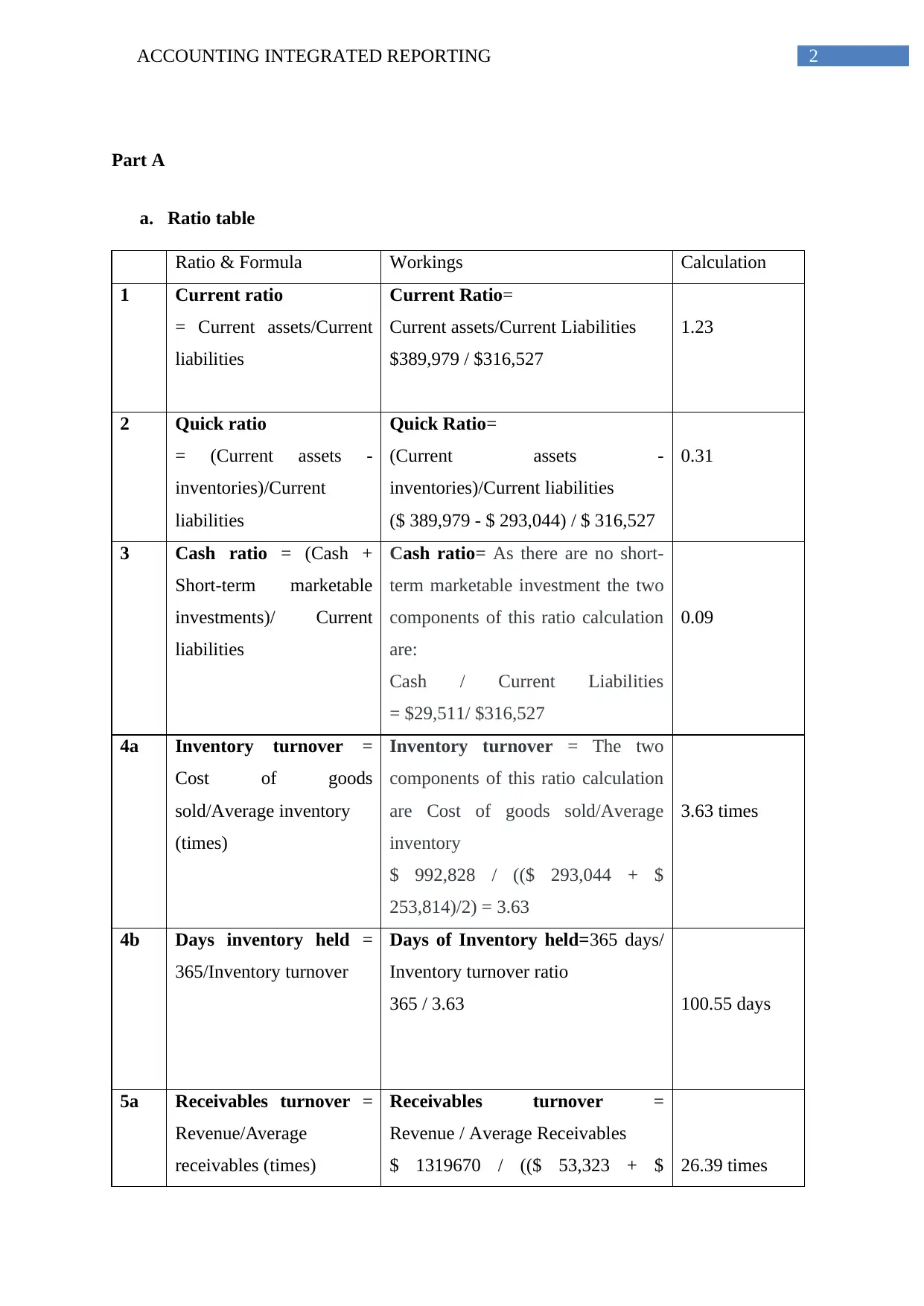
2ACCOUNTING INTEGRATED REPORTING
Part A
a. Ratio table
Ratio & Formula Workings Calculation
1 Current ratio
= Current assets/Current
liabilities
Current Ratio=
Current assets/Current Liabilities
$389,979 / $316,527
1.23
2 Quick ratio
= (Current assets -
inventories)/Current
liabilities
Quick Ratio=
(Current assets -
inventories)/Current liabilities
($ 389,979 - $ 293,044) / $ 316,527
0.31
3 Cash ratio = (Cash +
Short-term marketable
investments)/ Current
liabilities
Cash ratio= As there are no short-
term marketable investment the two
components of this ratio calculation
are:
Cash / Current Liabilities
= $29,511/ $316,527
0.09
4a Inventory turnover =
Cost of goods
sold/Average inventory
(times)
Inventory turnover = The two
components of this ratio calculation
are Cost of goods sold/Average
inventory
$ 992,828 / (($ 293,044 + $
253,814)/2) = 3.63
3.63 times
4b Days inventory held =
365/Inventory turnover
Days of Inventory held=365 days/
Inventory turnover ratio
365 / 3.63 100.55 days
5a Receivables turnover =
Revenue/Average
receivables (times)
Receivables turnover =
Revenue / Average Receivables
$ 1319670 / (($ 53,323 + $ 26.39 times
Part A
a. Ratio table
Ratio & Formula Workings Calculation
1 Current ratio
= Current assets/Current
liabilities
Current Ratio=
Current assets/Current Liabilities
$389,979 / $316,527
1.23
2 Quick ratio
= (Current assets -
inventories)/Current
liabilities
Quick Ratio=
(Current assets -
inventories)/Current liabilities
($ 389,979 - $ 293,044) / $ 316,527
0.31
3 Cash ratio = (Cash +
Short-term marketable
investments)/ Current
liabilities
Cash ratio= As there are no short-
term marketable investment the two
components of this ratio calculation
are:
Cash / Current Liabilities
= $29,511/ $316,527
0.09
4a Inventory turnover =
Cost of goods
sold/Average inventory
(times)
Inventory turnover = The two
components of this ratio calculation
are Cost of goods sold/Average
inventory
$ 992,828 / (($ 293,044 + $
253,814)/2) = 3.63
3.63 times
4b Days inventory held =
365/Inventory turnover
Days of Inventory held=365 days/
Inventory turnover ratio
365 / 3.63 100.55 days
5a Receivables turnover =
Revenue/Average
receivables (times)
Receivables turnover =
Revenue / Average Receivables
$ 1319670 / (($ 53,323 + $ 26.39 times
⊘ This is a preview!⊘
Do you want full access?
Subscribe today to unlock all pages.

Trusted by 1+ million students worldwide
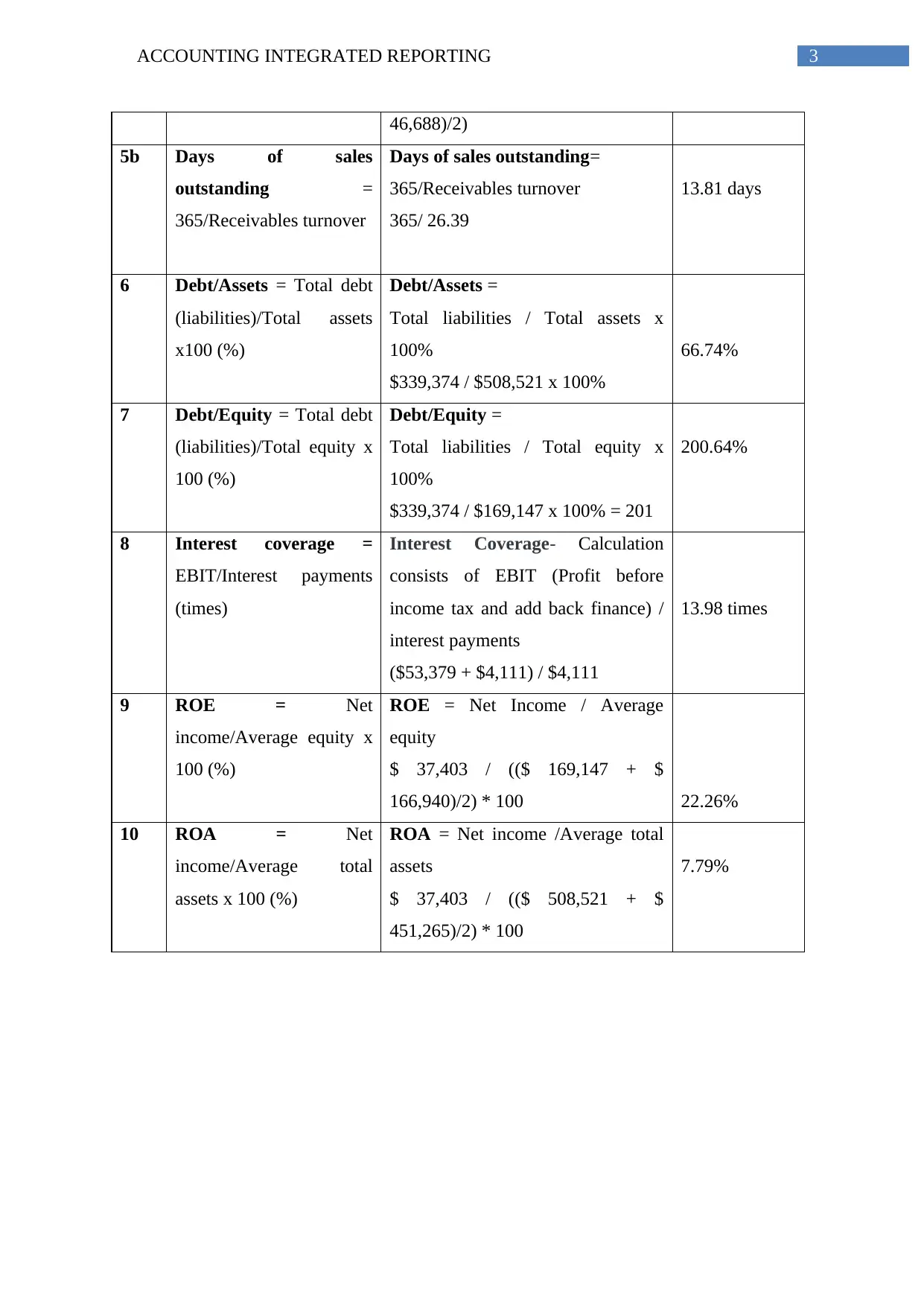
3ACCOUNTING INTEGRATED REPORTING
46,688)/2)
5b Days of sales
outstanding =
365/Receivables turnover
Days of sales outstanding=
365/Receivables turnover
365/ 26.39
13.81 days
6 Debt/Assets = Total debt
(liabilities)/Total assets
x100 (%)
Debt/Assets =
Total liabilities / Total assets x
100%
$339,374 / $508,521 x 100%
66.74%
7 Debt/Equity = Total debt
(liabilities)/Total equity x
100 (%)
Debt/Equity =
Total liabilities / Total equity x
100%
$339,374 / $169,147 x 100% = 201
200.64%
8 Interest coverage =
EBIT/Interest payments
(times)
Interest Coverage- Calculation
consists of EBIT (Profit before
income tax and add back finance) /
interest payments
($53,379 + $4,111) / $4,111
13.98 times
9 ROE = Net
income/Average equity x
100 (%)
ROE = Net Income / Average
equity
$ 37,403 / (($ 169,147 + $
166,940)/2) * 100 22.26%
10 ROA = Net
income/Average total
assets x 100 (%)
ROA = Net income /Average total
assets
$ 37,403 / (($ 508,521 + $
451,265)/2) * 100
7.79%
46,688)/2)
5b Days of sales
outstanding =
365/Receivables turnover
Days of sales outstanding=
365/Receivables turnover
365/ 26.39
13.81 days
6 Debt/Assets = Total debt
(liabilities)/Total assets
x100 (%)
Debt/Assets =
Total liabilities / Total assets x
100%
$339,374 / $508,521 x 100%
66.74%
7 Debt/Equity = Total debt
(liabilities)/Total equity x
100 (%)
Debt/Equity =
Total liabilities / Total equity x
100%
$339,374 / $169,147 x 100% = 201
200.64%
8 Interest coverage =
EBIT/Interest payments
(times)
Interest Coverage- Calculation
consists of EBIT (Profit before
income tax and add back finance) /
interest payments
($53,379 + $4,111) / $4,111
13.98 times
9 ROE = Net
income/Average equity x
100 (%)
ROE = Net Income / Average
equity
$ 37,403 / (($ 169,147 + $
166,940)/2) * 100 22.26%
10 ROA = Net
income/Average total
assets x 100 (%)
ROA = Net income /Average total
assets
$ 37,403 / (($ 508,521 + $
451,265)/2) * 100
7.79%
Paraphrase This Document
Need a fresh take? Get an instant paraphrase of this document with our AI Paraphraser
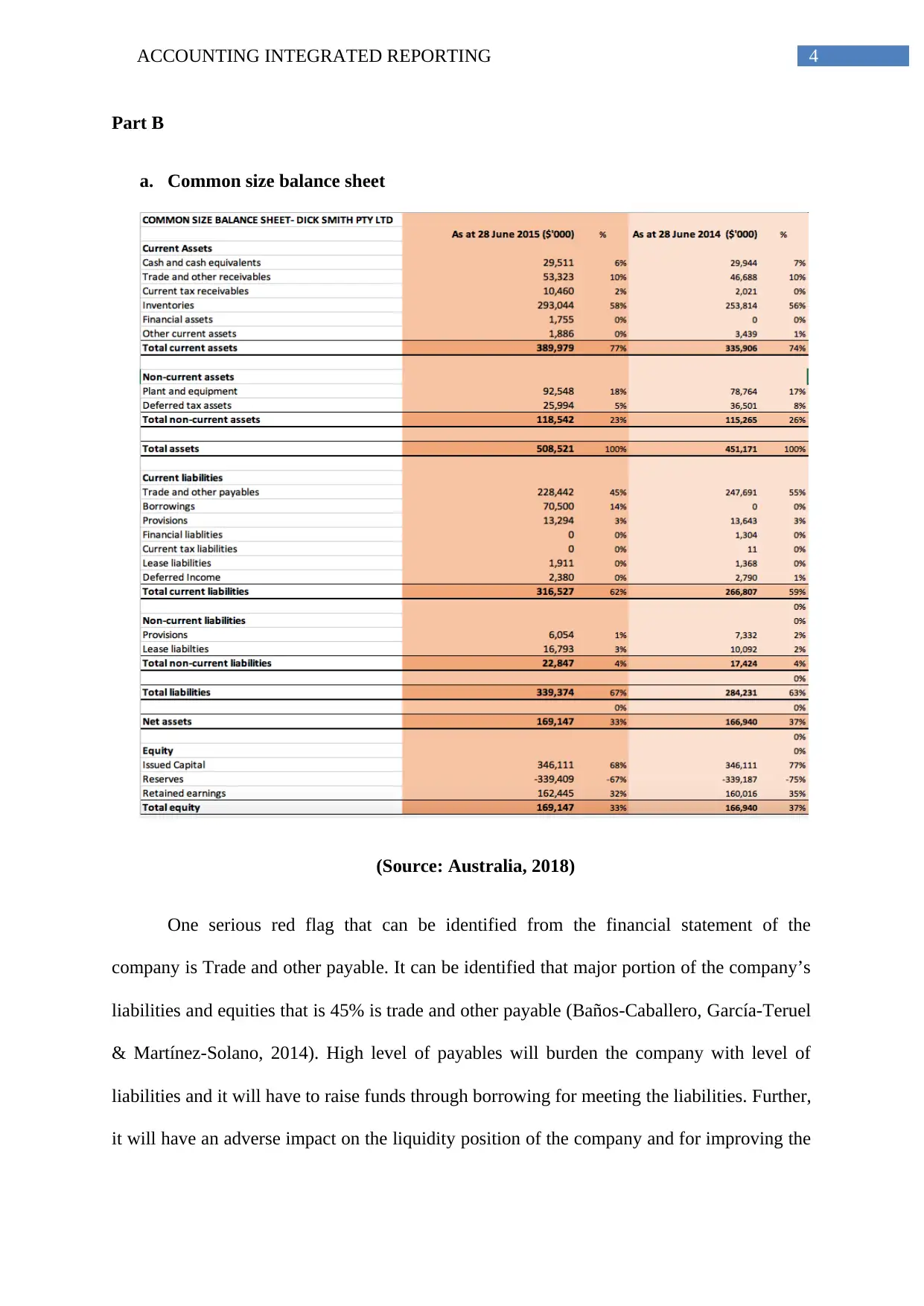
4ACCOUNTING INTEGRATED REPORTING
Part B
a. Common size balance sheet
(Source: Australia, 2018)
One serious red flag that can be identified from the financial statement of the
company is Trade and other payable. It can be identified that major portion of the company’s
liabilities and equities that is 45% is trade and other payable (Baños-Caballero, García-Teruel
& Martínez-Solano, 2014). High level of payables will burden the company with level of
liabilities and it will have to raise funds through borrowing for meeting the liabilities. Further,
it will have an adverse impact on the liquidity position of the company and for improving the
Part B
a. Common size balance sheet
(Source: Australia, 2018)
One serious red flag that can be identified from the financial statement of the
company is Trade and other payable. It can be identified that major portion of the company’s
liabilities and equities that is 45% is trade and other payable (Baños-Caballero, García-Teruel
& Martínez-Solano, 2014). High level of payables will burden the company with level of
liabilities and it will have to raise funds through borrowing for meeting the liabilities. Further,
it will have an adverse impact on the liquidity position of the company and for improving the
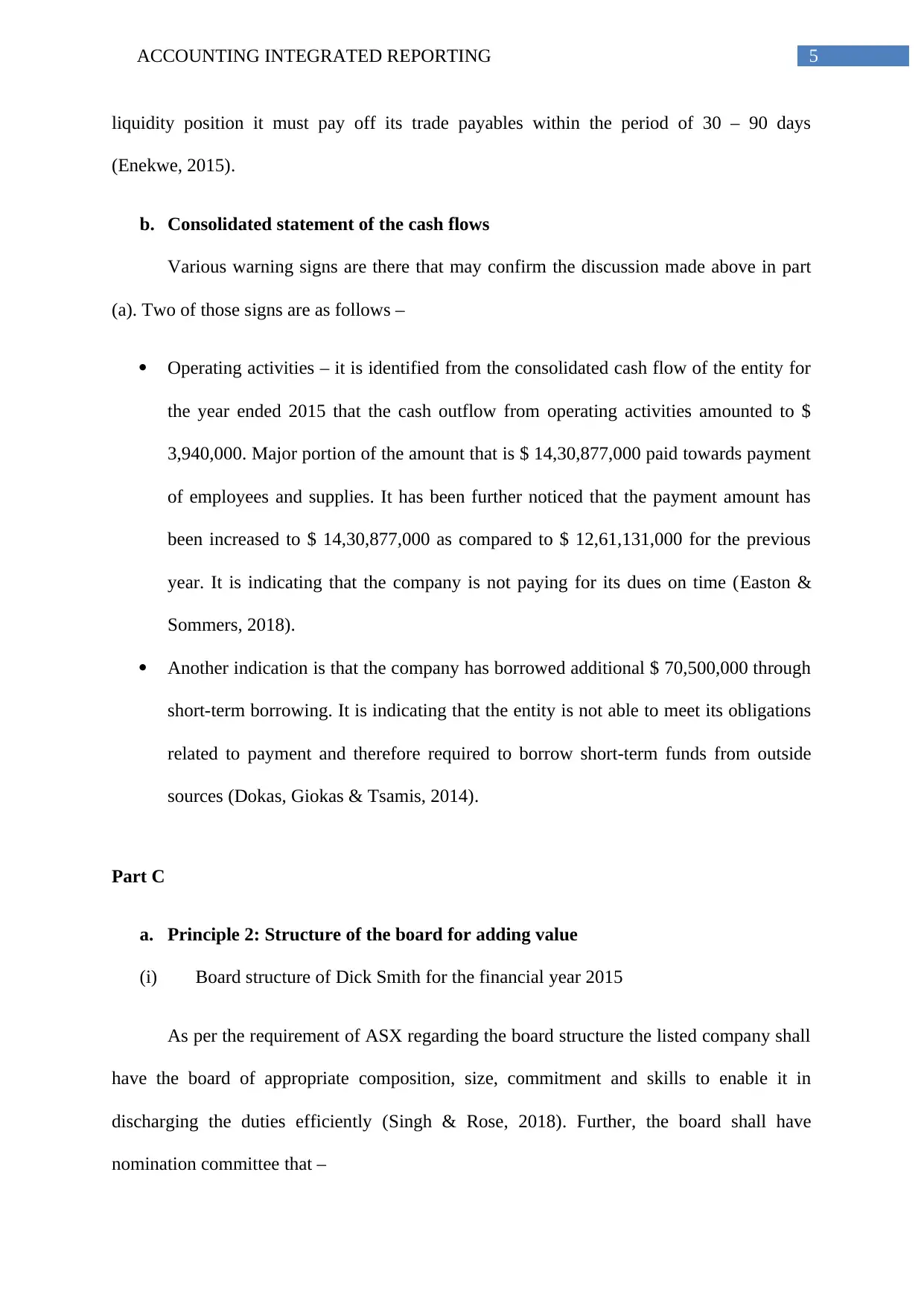
5ACCOUNTING INTEGRATED REPORTING
liquidity position it must pay off its trade payables within the period of 30 – 90 days
(Enekwe, 2015).
b. Consolidated statement of the cash flows
Various warning signs are there that may confirm the discussion made above in part
(a). Two of those signs are as follows –
Operating activities – it is identified from the consolidated cash flow of the entity for
the year ended 2015 that the cash outflow from operating activities amounted to $
3,940,000. Major portion of the amount that is $ 14,30,877,000 paid towards payment
of employees and supplies. It has been further noticed that the payment amount has
been increased to $ 14,30,877,000 as compared to $ 12,61,131,000 for the previous
year. It is indicating that the company is not paying for its dues on time (Easton &
Sommers, 2018).
Another indication is that the company has borrowed additional $ 70,500,000 through
short-term borrowing. It is indicating that the entity is not able to meet its obligations
related to payment and therefore required to borrow short-term funds from outside
sources (Dokas, Giokas & Tsamis, 2014).
Part C
a. Principle 2: Structure of the board for adding value
(i) Board structure of Dick Smith for the financial year 2015
As per the requirement of ASX regarding the board structure the listed company shall
have the board of appropriate composition, size, commitment and skills to enable it in
discharging the duties efficiently (Singh & Rose, 2018). Further, the board shall have
nomination committee that –
liquidity position it must pay off its trade payables within the period of 30 – 90 days
(Enekwe, 2015).
b. Consolidated statement of the cash flows
Various warning signs are there that may confirm the discussion made above in part
(a). Two of those signs are as follows –
Operating activities – it is identified from the consolidated cash flow of the entity for
the year ended 2015 that the cash outflow from operating activities amounted to $
3,940,000. Major portion of the amount that is $ 14,30,877,000 paid towards payment
of employees and supplies. It has been further noticed that the payment amount has
been increased to $ 14,30,877,000 as compared to $ 12,61,131,000 for the previous
year. It is indicating that the company is not paying for its dues on time (Easton &
Sommers, 2018).
Another indication is that the company has borrowed additional $ 70,500,000 through
short-term borrowing. It is indicating that the entity is not able to meet its obligations
related to payment and therefore required to borrow short-term funds from outside
sources (Dokas, Giokas & Tsamis, 2014).
Part C
a. Principle 2: Structure of the board for adding value
(i) Board structure of Dick Smith for the financial year 2015
As per the requirement of ASX regarding the board structure the listed company shall
have the board of appropriate composition, size, commitment and skills to enable it in
discharging the duties efficiently (Singh & Rose, 2018). Further, the board shall have
nomination committee that –
⊘ This is a preview!⊘
Do you want full access?
Subscribe today to unlock all pages.

Trusted by 1+ million students worldwide
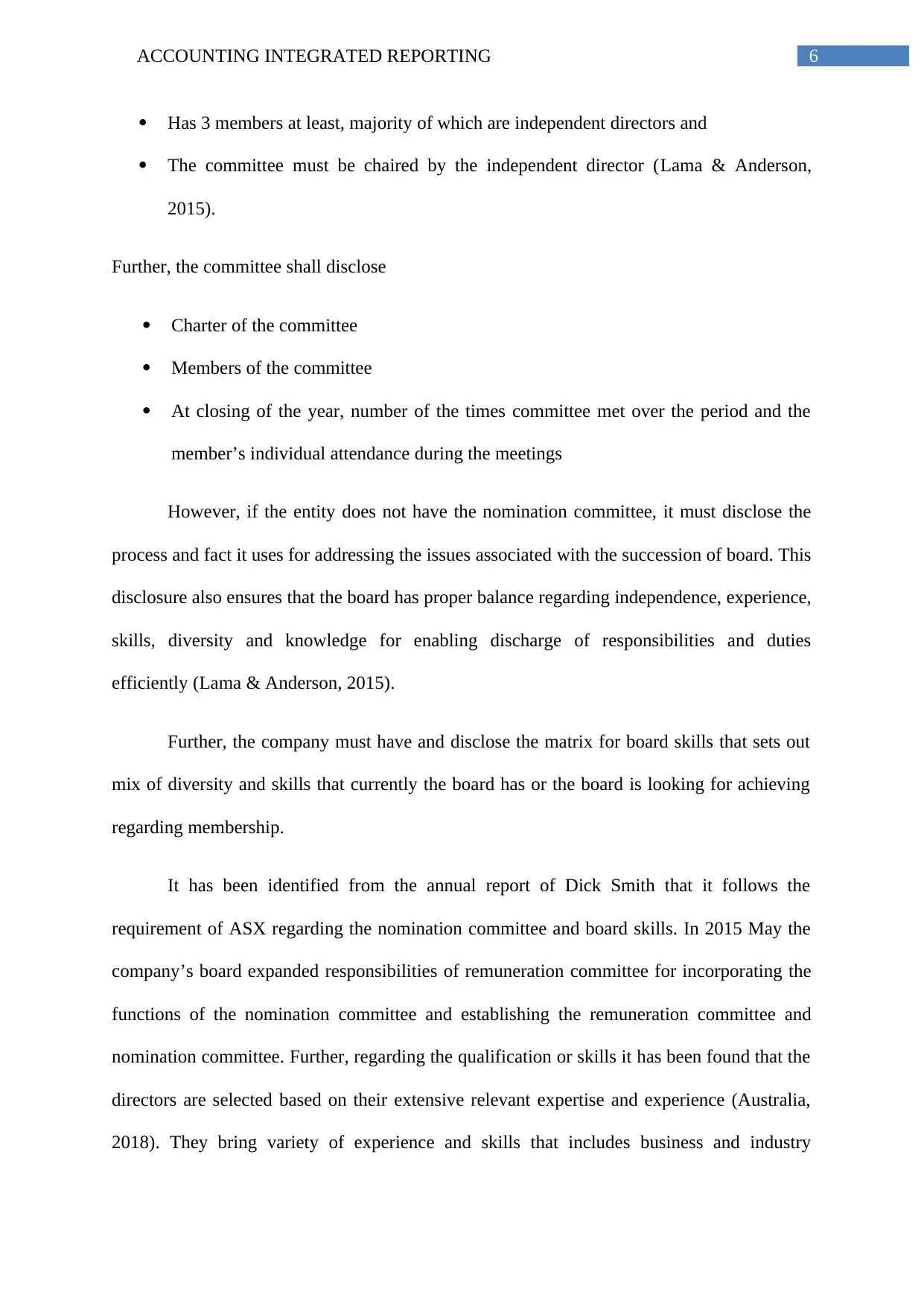
6ACCOUNTING INTEGRATED REPORTING
Has 3 members at least, majority of which are independent directors and
The committee must be chaired by the independent director (Lama & Anderson,
2015).
Further, the committee shall disclose
Charter of the committee
Members of the committee
At closing of the year, number of the times committee met over the period and the
member’s individual attendance during the meetings
However, if the entity does not have the nomination committee, it must disclose the
process and fact it uses for addressing the issues associated with the succession of board. This
disclosure also ensures that the board has proper balance regarding independence, experience,
skills, diversity and knowledge for enabling discharge of responsibilities and duties
efficiently (Lama & Anderson, 2015).
Further, the company must have and disclose the matrix for board skills that sets out
mix of diversity and skills that currently the board has or the board is looking for achieving
regarding membership.
It has been identified from the annual report of Dick Smith that it follows the
requirement of ASX regarding the nomination committee and board skills. In 2015 May the
company’s board expanded responsibilities of remuneration committee for incorporating the
functions of the nomination committee and establishing the remuneration committee and
nomination committee. Further, regarding the qualification or skills it has been found that the
directors are selected based on their extensive relevant expertise and experience (Australia,
2018). They bring variety of experience and skills that includes business and industry
Has 3 members at least, majority of which are independent directors and
The committee must be chaired by the independent director (Lama & Anderson,
2015).
Further, the committee shall disclose
Charter of the committee
Members of the committee
At closing of the year, number of the times committee met over the period and the
member’s individual attendance during the meetings
However, if the entity does not have the nomination committee, it must disclose the
process and fact it uses for addressing the issues associated with the succession of board. This
disclosure also ensures that the board has proper balance regarding independence, experience,
skills, diversity and knowledge for enabling discharge of responsibilities and duties
efficiently (Lama & Anderson, 2015).
Further, the company must have and disclose the matrix for board skills that sets out
mix of diversity and skills that currently the board has or the board is looking for achieving
regarding membership.
It has been identified from the annual report of Dick Smith that it follows the
requirement of ASX regarding the nomination committee and board skills. In 2015 May the
company’s board expanded responsibilities of remuneration committee for incorporating the
functions of the nomination committee and establishing the remuneration committee and
nomination committee. Further, regarding the qualification or skills it has been found that the
directors are selected based on their extensive relevant expertise and experience (Australia,
2018). They bring variety of experience and skills that includes business and industry
Paraphrase This Document
Need a fresh take? Get an instant paraphrase of this document with our AI Paraphraser
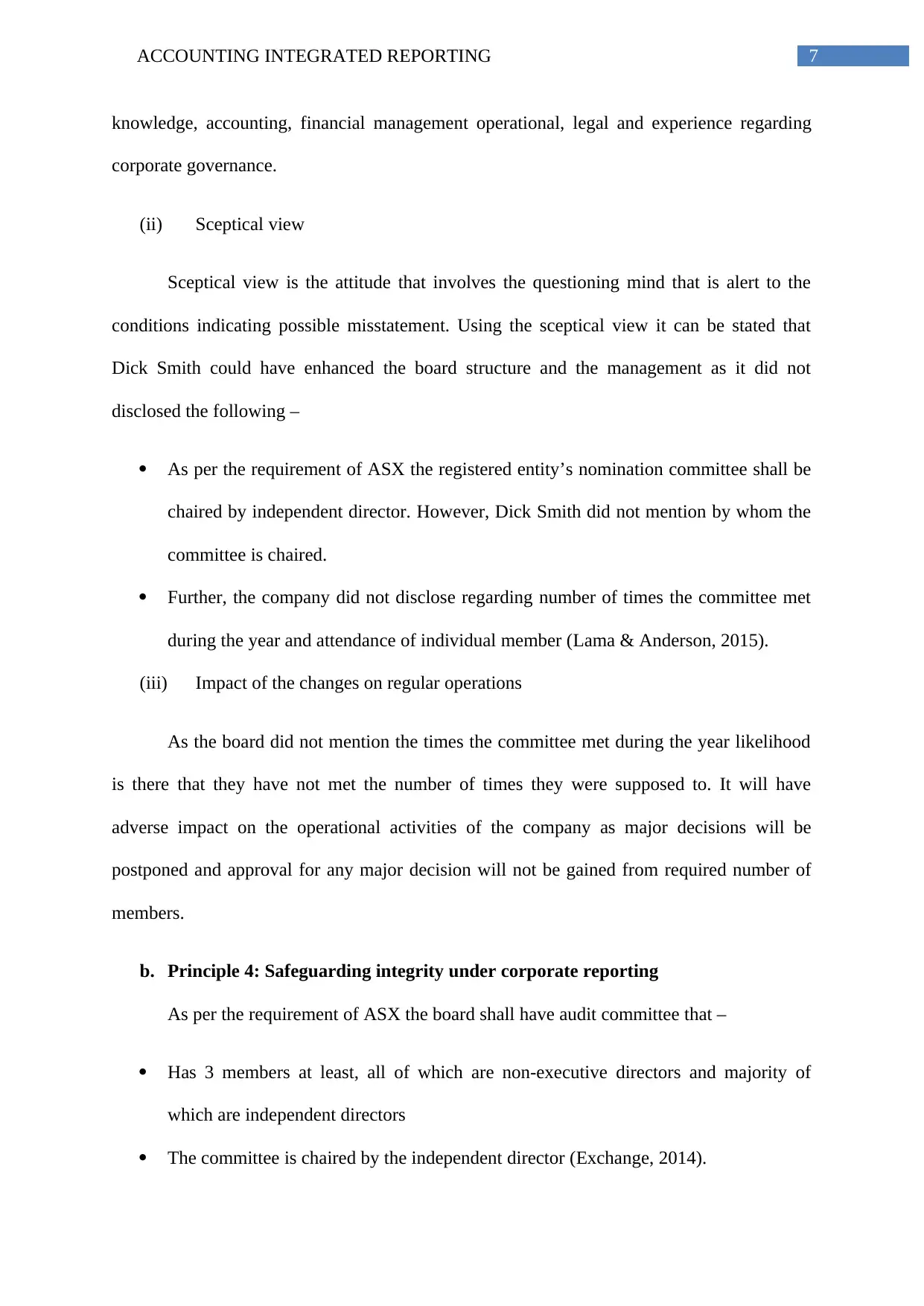
7ACCOUNTING INTEGRATED REPORTING
knowledge, accounting, financial management operational, legal and experience regarding
corporate governance.
(ii) Sceptical view
Sceptical view is the attitude that involves the questioning mind that is alert to the
conditions indicating possible misstatement. Using the sceptical view it can be stated that
Dick Smith could have enhanced the board structure and the management as it did not
disclosed the following –
As per the requirement of ASX the registered entity’s nomination committee shall be
chaired by independent director. However, Dick Smith did not mention by whom the
committee is chaired.
Further, the company did not disclose regarding number of times the committee met
during the year and attendance of individual member (Lama & Anderson, 2015).
(iii) Impact of the changes on regular operations
As the board did not mention the times the committee met during the year likelihood
is there that they have not met the number of times they were supposed to. It will have
adverse impact on the operational activities of the company as major decisions will be
postponed and approval for any major decision will not be gained from required number of
members.
b. Principle 4: Safeguarding integrity under corporate reporting
As per the requirement of ASX the board shall have audit committee that –
Has 3 members at least, all of which are non-executive directors and majority of
which are independent directors
The committee is chaired by the independent director (Exchange, 2014).
knowledge, accounting, financial management operational, legal and experience regarding
corporate governance.
(ii) Sceptical view
Sceptical view is the attitude that involves the questioning mind that is alert to the
conditions indicating possible misstatement. Using the sceptical view it can be stated that
Dick Smith could have enhanced the board structure and the management as it did not
disclosed the following –
As per the requirement of ASX the registered entity’s nomination committee shall be
chaired by independent director. However, Dick Smith did not mention by whom the
committee is chaired.
Further, the company did not disclose regarding number of times the committee met
during the year and attendance of individual member (Lama & Anderson, 2015).
(iii) Impact of the changes on regular operations
As the board did not mention the times the committee met during the year likelihood
is there that they have not met the number of times they were supposed to. It will have
adverse impact on the operational activities of the company as major decisions will be
postponed and approval for any major decision will not be gained from required number of
members.
b. Principle 4: Safeguarding integrity under corporate reporting
As per the requirement of ASX the board shall have audit committee that –
Has 3 members at least, all of which are non-executive directors and majority of
which are independent directors
The committee is chaired by the independent director (Exchange, 2014).

8ACCOUNTING INTEGRATED REPORTING
Further, the committee shall disclose
Charter of the committee
Relevant experience and qualification of the committee’s member.
At closing of the year, number of times the committee met over the period and the
member’s individual attendance during the meetings (Exchange, 2014).
However, if the company does not have the audit committee, it must disclose the
process and fact it uses for addressing the issues associated with the succession of board. This
disclosure also ensures that the board has proper balance regarding independence, experience,
skills, diversity and knowledge for enabling discharge of responsibilities and duties
efficiently (Singh & Rose, 2018).
The board shall before approving the financial statement receive the declaration from
CFO and CEO the statement in their opinion are maintained properly and complied with the
AS and provides true and fair view of the company’s financial position and performance
(Exchange, 2014).
Further, the entity that has AGM shall assure that the external auditors are attending
the AGM and they are available for answering the questions from the security holder those
are relevant to audit.
It has been found from the annual report Of Dick Smith for the year ended 2015
complied with all the requirements of ASX regarding principle 4. It established the audit and
finance committee the main purpose of which is assisting board regarding carrying out of the
financial, auditing and accounting reporting. Further, before approving the financial
statement board received written declaration from CEO and each managing director as per
the compliance with Section 295A of Corporation Act 2001. Further, the external auditor of
Further, the committee shall disclose
Charter of the committee
Relevant experience and qualification of the committee’s member.
At closing of the year, number of times the committee met over the period and the
member’s individual attendance during the meetings (Exchange, 2014).
However, if the company does not have the audit committee, it must disclose the
process and fact it uses for addressing the issues associated with the succession of board. This
disclosure also ensures that the board has proper balance regarding independence, experience,
skills, diversity and knowledge for enabling discharge of responsibilities and duties
efficiently (Singh & Rose, 2018).
The board shall before approving the financial statement receive the declaration from
CFO and CEO the statement in their opinion are maintained properly and complied with the
AS and provides true and fair view of the company’s financial position and performance
(Exchange, 2014).
Further, the entity that has AGM shall assure that the external auditors are attending
the AGM and they are available for answering the questions from the security holder those
are relevant to audit.
It has been found from the annual report Of Dick Smith for the year ended 2015
complied with all the requirements of ASX regarding principle 4. It established the audit and
finance committee the main purpose of which is assisting board regarding carrying out of the
financial, auditing and accounting reporting. Further, before approving the financial
statement board received written declaration from CEO and each managing director as per
the compliance with Section 295A of Corporation Act 2001. Further, the external auditor of
⊘ This is a preview!⊘
Do you want full access?
Subscribe today to unlock all pages.

Trusted by 1+ million students worldwide
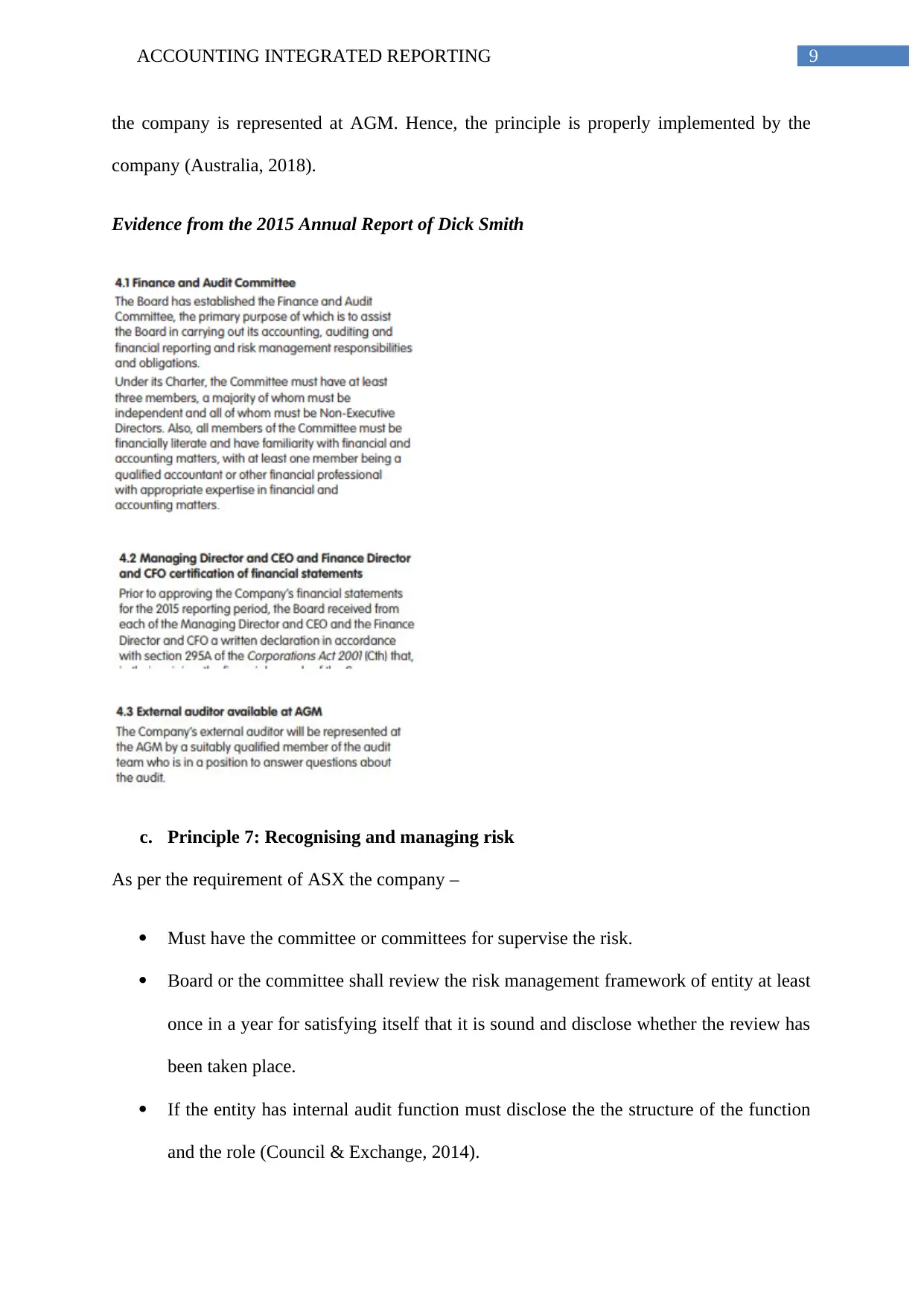
9ACCOUNTING INTEGRATED REPORTING
the company is represented at AGM. Hence, the principle is properly implemented by the
company (Australia, 2018).
Evidence from the 2015 Annual Report of Dick Smith
c. Principle 7: Recognising and managing risk
As per the requirement of ASX the company –
Must have the committee or committees for supervise the risk.
Board or the committee shall review the risk management framework of entity at least
once in a year for satisfying itself that it is sound and disclose whether the review has
been taken place.
If the entity has internal audit function must disclose the the structure of the function
and the role (Council & Exchange, 2014).
the company is represented at AGM. Hence, the principle is properly implemented by the
company (Australia, 2018).
Evidence from the 2015 Annual Report of Dick Smith
c. Principle 7: Recognising and managing risk
As per the requirement of ASX the company –
Must have the committee or committees for supervise the risk.
Board or the committee shall review the risk management framework of entity at least
once in a year for satisfying itself that it is sound and disclose whether the review has
been taken place.
If the entity has internal audit function must disclose the the structure of the function
and the role (Council & Exchange, 2014).
Paraphrase This Document
Need a fresh take? Get an instant paraphrase of this document with our AI Paraphraser
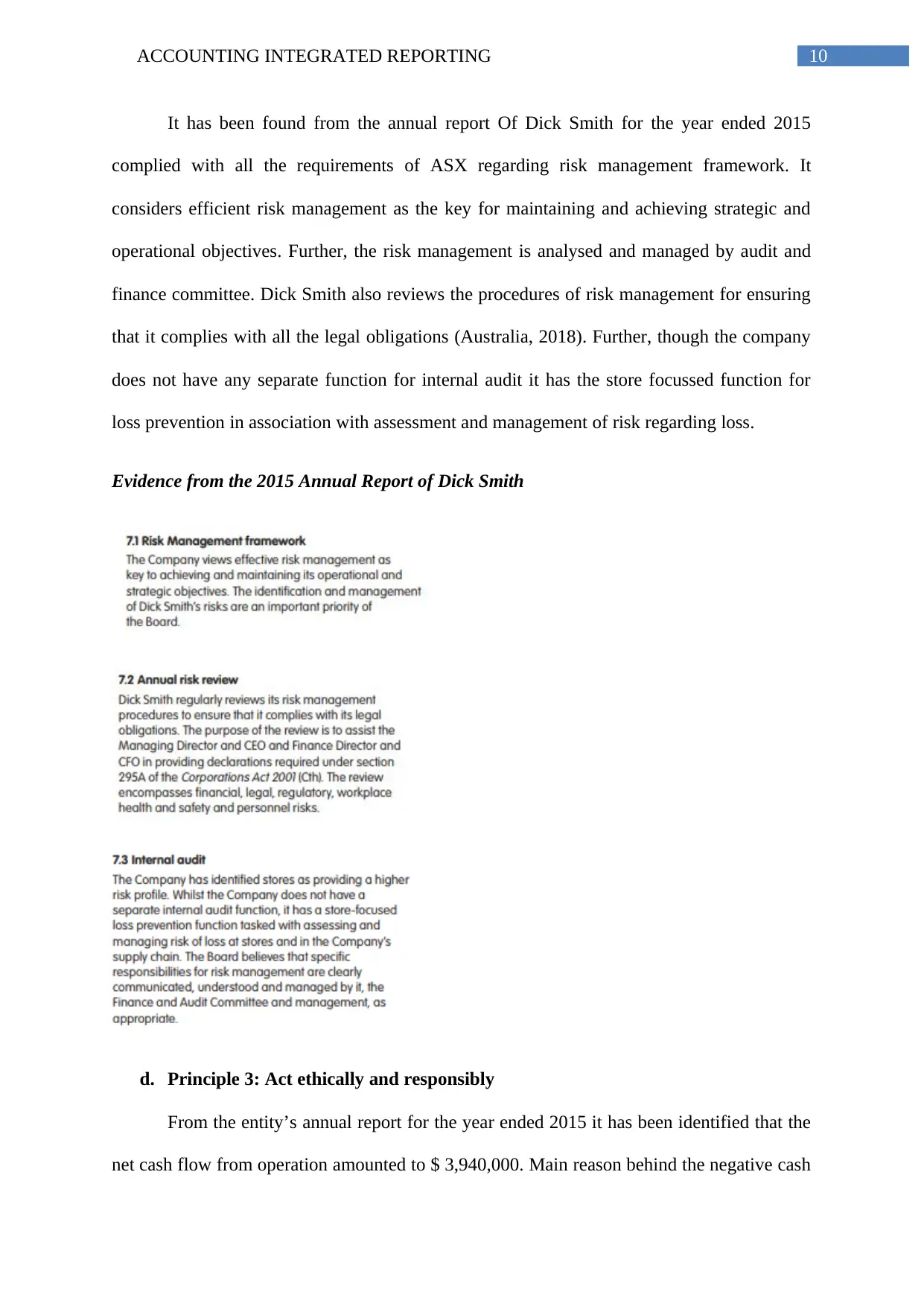
10ACCOUNTING INTEGRATED REPORTING
It has been found from the annual report Of Dick Smith for the year ended 2015
complied with all the requirements of ASX regarding risk management framework. It
considers efficient risk management as the key for maintaining and achieving strategic and
operational objectives. Further, the risk management is analysed and managed by audit and
finance committee. Dick Smith also reviews the procedures of risk management for ensuring
that it complies with all the legal obligations (Australia, 2018). Further, though the company
does not have any separate function for internal audit it has the store focussed function for
loss prevention in association with assessment and management of risk regarding loss.
Evidence from the 2015 Annual Report of Dick Smith
d. Principle 3: Act ethically and responsibly
From the entity’s annual report for the year ended 2015 it has been identified that the
net cash flow from operation amounted to $ 3,940,000. Main reason behind the negative cash
It has been found from the annual report Of Dick Smith for the year ended 2015
complied with all the requirements of ASX regarding risk management framework. It
considers efficient risk management as the key for maintaining and achieving strategic and
operational objectives. Further, the risk management is analysed and managed by audit and
finance committee. Dick Smith also reviews the procedures of risk management for ensuring
that it complies with all the legal obligations (Australia, 2018). Further, though the company
does not have any separate function for internal audit it has the store focussed function for
loss prevention in association with assessment and management of risk regarding loss.
Evidence from the 2015 Annual Report of Dick Smith
d. Principle 3: Act ethically and responsibly
From the entity’s annual report for the year ended 2015 it has been identified that the
net cash flow from operation amounted to $ 3,940,000. Main reason behind the negative cash
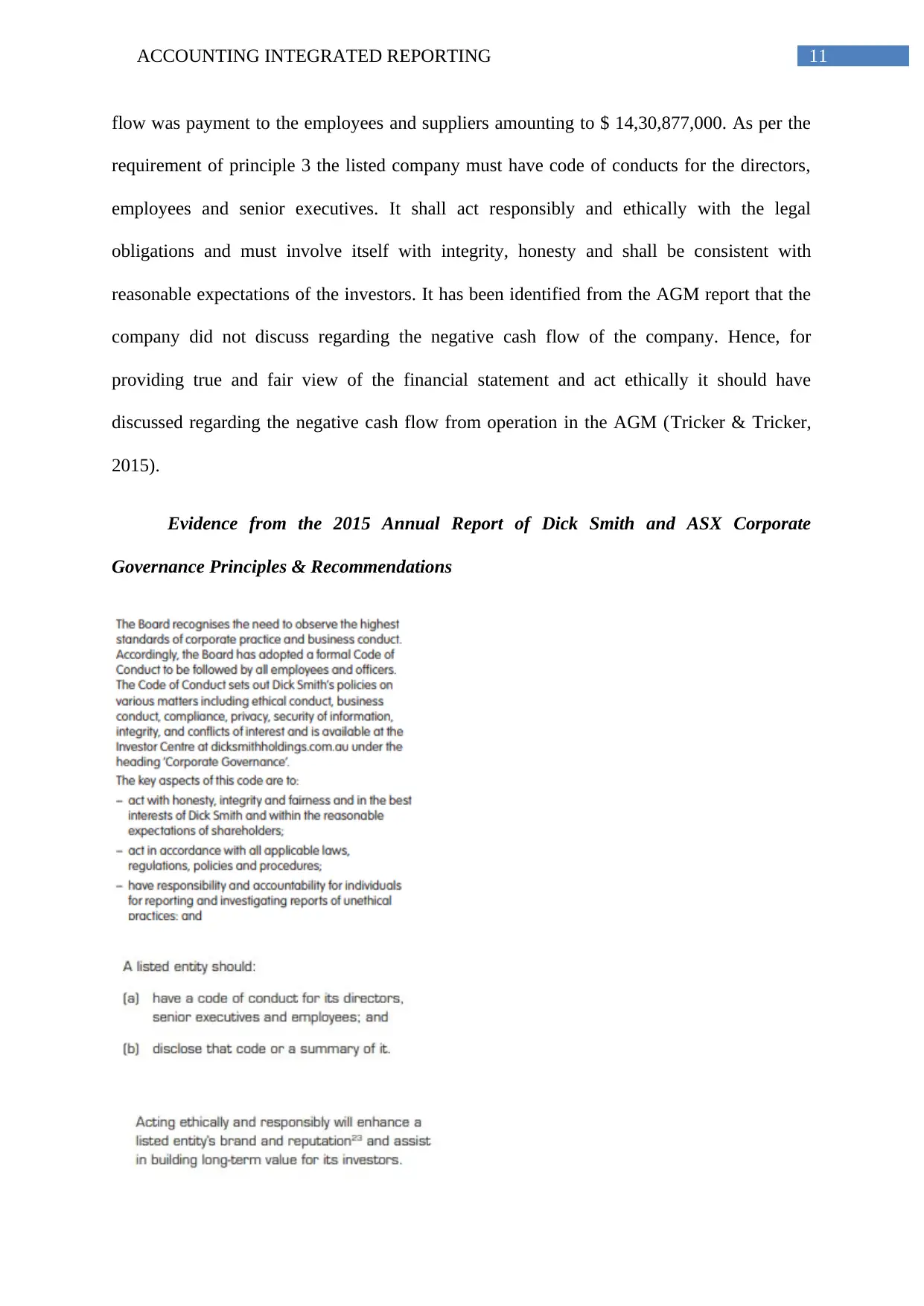
11ACCOUNTING INTEGRATED REPORTING
flow was payment to the employees and suppliers amounting to $ 14,30,877,000. As per the
requirement of principle 3 the listed company must have code of conducts for the directors,
employees and senior executives. It shall act responsibly and ethically with the legal
obligations and must involve itself with integrity, honesty and shall be consistent with
reasonable expectations of the investors. It has been identified from the AGM report that the
company did not discuss regarding the negative cash flow of the company. Hence, for
providing true and fair view of the financial statement and act ethically it should have
discussed regarding the negative cash flow from operation in the AGM (Tricker & Tricker,
2015).
Evidence from the 2015 Annual Report of Dick Smith and ASX Corporate
Governance Principles & Recommendations
flow was payment to the employees and suppliers amounting to $ 14,30,877,000. As per the
requirement of principle 3 the listed company must have code of conducts for the directors,
employees and senior executives. It shall act responsibly and ethically with the legal
obligations and must involve itself with integrity, honesty and shall be consistent with
reasonable expectations of the investors. It has been identified from the AGM report that the
company did not discuss regarding the negative cash flow of the company. Hence, for
providing true and fair view of the financial statement and act ethically it should have
discussed regarding the negative cash flow from operation in the AGM (Tricker & Tricker,
2015).
Evidence from the 2015 Annual Report of Dick Smith and ASX Corporate
Governance Principles & Recommendations
⊘ This is a preview!⊘
Do you want full access?
Subscribe today to unlock all pages.

Trusted by 1+ million students worldwide
1 out of 14
Related Documents
Your All-in-One AI-Powered Toolkit for Academic Success.
+13062052269
info@desklib.com
Available 24*7 on WhatsApp / Email
![[object Object]](/_next/static/media/star-bottom.7253800d.svg)
Unlock your academic potential
Copyright © 2020–2025 A2Z Services. All Rights Reserved. Developed and managed by ZUCOL.




